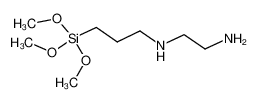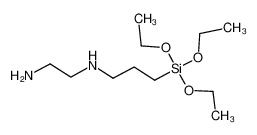
N-[3-(Trimethoxysilyl)propyl]ethylenediamine
CAS NO.: 1760-24-3
Purity :98%

N-(2-Aminoethyl)-3-Aminopropyltriethoxysilane
CAS NO.: 5089-72-5
Purity :97%

N-(3-trimethoxysilylpropyl)cyclohexanamine
CAS NO.: 3068-78-8
Purity :97%
| Compound | 3-Methacryloxypropyltrimethoxysilane | ||||
|---|---|---|---|---|---|
| CAS No. | 2530-85-0 | Catalog No. | GX-570 KBM-503 A-174 | Brand | |
| Purity | 99.5% | Packing | 1kg | Grade | |
| Lead Time | 14Day (s) | Origin | Loading Port | ||
| Boiling Point | 190ºC |
|---|---|
| Stability | Stable under normal temperatures and pressures. |
| Storage Condition | 2-8ºC |
| Appearance & Physical State | colorless transparent liquid |
| Flash Point | 92ºC |
| Refractive Index | 1.43-1.432 |
| Density | 1.045 |
| Melting Point | <-50ºC |
| Vapor Pressure | 0.089mmHg at 25°C |
GX-570 is a bifunctional silane possessing a methacrylic organofunctional group and a tri- mehoxysilyl inorganic group. The dual nature of its reactivity allows it to bind chemically to both inorganic materials (e.g. glass, silica) and organic thermoset resins thus functioning as adhesion promoter, co-monomer for polymer synthesis, crosslinker, and surface modifier.
The use of GX-570 as a coupling agent in glass fiber-reinforced or filler-modified plastics improves filler dispersibility while reducing the filler's sedimentation tendency. It also results in a major reduction in the melt viscosity of casting resins, as well as a marked improvement in the mechanical properties of glass-fiber-reinforced or mineral-filled plastics. In addition, use of GX-570 in these materials leads to a sizable increase in moisture (vapor) resistance as well as greater resistance to acids and bases. Used as a co-monomer in
polymers, GX-570 produces binders that exhibit much improved wet scrub, abrasion and scratch resistance because of crosslinking and strong adhesion to the base. As a component of free-radical curable adhesives and sealants, it leads to improved mechanical properties and enhanced substrate adhesion.
GX-570 is a clear, colorless, light and heat sensitive liquid with a characteristically sweet odor. It is soluble in alcohols, and aliphatic or aromatic hydrocarbons.
Technical data
Typical characteristics | Value |
Appearance | colorless transparent liquid |
Purity | 96.0% |
Density at 25 | 1.045g/ml |
Boiling point at 760mmHg | 255 |
Flash point | 108 |
Refractive index at 25 | 1.430 |
Reactivity
GX-570 is highly miscible with standard organic solvents, such as alcohols, toluene and acetone, but practically is insoluble in neutral water. However, by adjusting the pH to between 3 and 4 with a hydrolysis catalyst (e.g. acetic acid), an aqueous solution of up to 5 percent by weight can be obtained. The resulting clear solution should be used as soon as possible (within 1-2 days), before siloxane formation has proceeded too far. Deactivation of GX-570 by siloxane formation is signalized by clouding of the aqueous solution.
The hydrolysis of alkoxy group produce methanol and reactive silanol (Si-OH) groups
which can bond to a variety of inorganic substrates. The methacrylate groups interact with the polymer. Examples of suitable inorganic substrates are glass, glass fibers, glass wool, mineral wool, silicic acid, quartz, sand, cristobalite, wollastonite, silicate fillers, metal oxides and metals. Examples of suitable polymers include unsaturated polyester, vinyl esters and acrylates.
Application and performance
GX-570 is used as adhesion promoter in application such as:
A constituent of glass fiber sizes (glass fiber fillers for unsaturated polyester resins and polyolefins).
A finish for glass fabrics used in unsaturated polyester resins.
As a surface modifier for pigments and fillers for thermosets (unsaturated polyester, such as MMA), thermoplastics (such as polyesters and polyolefins) and elastomers.
As an additive for filler, peroxide- crosslinked elastomers.
As an additive for casting resins (un- saturated polyester, MMA).
LT570 is either applied to the inorganic substrate as a pretreatment by dipping, spraying, or coating or it may be added directly to the resin matrix (additive process). For pretreatment, the silane may be used
Neat
Dissolved in an organic solvent.
Dissolved in a mixture of organic solvent and water for partial hydrolysis.
Completely hydrolyzed in aqueous solution.
To prepare an aqueous pretreatment solution, approx. 1-5wt% GX-570 is dissolved in water that has been adjusted to pH 3-4 with acetic acid. The solution will turns clear when the
silane has fully hydrolyzed. The clear solution of GX-570 hydrolysate must be used within 1-2 days; if it turns cloudy again it may no longer be used. In the additive process, LT570 is mixed with the resin or polymer before or together with the filler. A prerequisite for this method is compatibility of the silane with the resin since the silane must not react prematurely with the resin.
When used correctly GX-570 can achieve the following properties, for example in a highly-filled unsaturated resin system:
Optimum dispersion of the fillers/ pigments.
Reduction in settling of the fillers/ pigments.
A reduction in viscosity and improved flow properties of the resin.
Improved mechanical properties of the molded products.
Improved resistance of the molded products to boiling water, acids and alkalis.
GX-570 can be used as monomer during resin synthesis (e.g. latex dispersions). It may partially replace the methacryl-functional monomers (usually 0.5-3%, but sometimes up to 20%). The thus incorporated silane functionality can lead to improved properties in the final application (e.g. coating or sealant) of such resins:
Wet adhesion strength.
Chemical resistance.
Mar resistance.
3-Methacryloxypropyltrimethoxysilane
CAS No : 2530-85-0
(2R)-5-amino-2-[(2-methylpropan-2-yl)oxycarbonylamino]pentanoic acid
CAS No : 159877-12-0
3-O-tert-butyl 1-O-methyl 2-amino-2-(2-hydroxyethyl)propanedioate
CAS No : 258351-86-9
2-[(2-amino-3-methylbutanoyl)amino]-4-methylsulfanylbutanoic acid
CAS No : 14486-09-0
[2-(carbamoyloxymethyl)-2,3-dimethylpentyl] carbamate
CAS No : 64-55-1
2-[2-(1-carboxypropylamino)ethylamino]butanoic acid
CAS No : 498-17-9
CAS No : 85006-25-3
(2R,5S)-rel-Diethyl 2,5-dibromohexanedioate
CAS No : 54221-37-3
CAS No : 2487-90-3
3-chloropropyl(trimethoxy)silane
CAS No : 2530-87-2
CAS No : 5536-61-8
CAS No : 1634-04-4
CAS No : 79-41-4
CAS No : 10025-78-2
CAS No : 96-05-9
3-trichlorosilylpropyl 2-methylprop-2-enoate
CAS No : 7351-61-3
3-(Methacryloyloxy)Propyltris(Trimethylsiloxy)Silane
CAS No : 17096-07-0
CAS No : 994-49-0
CAS No : 150-76-5
CAS No : 99-97-8
CAS No : 307531-94-8